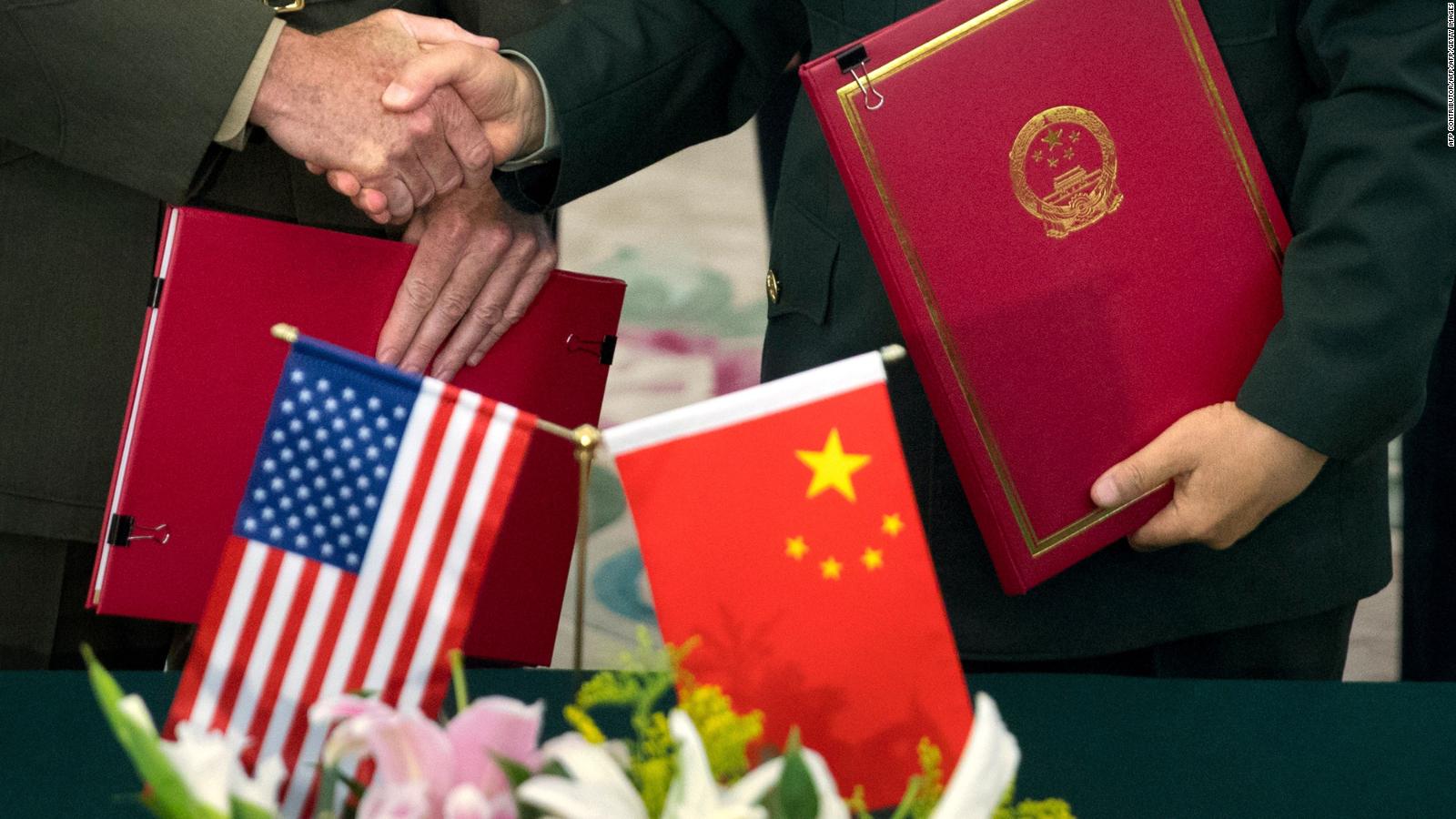Strained Ties: Analyzing The Breakdown In U.S.-China Relations And The Risk Of A New Cold War

Table of Contents
Historical Context: From Cooperation to Confrontation
The evolution of U.S.-China relations is a complex tapestry woven with threads of cooperation and conflict. Following the establishment of diplomatic ties in 1979, periods of significant cooperation existed, particularly in the realm of trade. Early engagement fostered economic growth for both nations, leading to substantial trade agreements and intertwined economic interests. However, this seemingly harmonious relationship began to fray as points of contention emerged and intensified.
- Periods of Cooperation: The initial period of engagement after Nixon's visit to China saw significant cooperation on various fronts, including cultural exchange and economic partnerships. Bilateral trade flourished, benefiting both economies.
- Emerging Points of Contention: Differences over Taiwan's status, human rights concerns in China, and persistent trade imbalances began to strain Sino-American relations. These issues, while initially manageable, grew increasingly contentious.
- Key Events that Escalated Tensions: The 2018 trade war, marked by escalating tariffs and retaliatory measures, significantly damaged bilateral ties. Technological competition, particularly in areas like 5G and artificial intelligence, further fueled the growing friction. These events solidified a shift from cooperation to confrontation in U.S.-China relations.
Economic Competition and Trade Wars: A Major Source of Friction
Economic competition has become a primary driver of friction in U.S.-China relations. Massive trade deficits, coupled with accusations of unfair trade practices and intellectual property theft, have fueled protectionist sentiments in the U.S. This led to the imposition of tariffs, sparking a trade war that significantly impacted global markets.
- Trade Deficits and Protectionist Measures: The persistent U.S. trade deficit with China has been a long-standing source of tension, contributing to the rise of protectionist measures in the United States.
- The Impact of Tariffs and Trade Wars: The trade war resulted in significant economic disruption, affecting businesses and consumers worldwide. Supply chains were disrupted, and global growth slowed.
- Technological Competition and Intellectual Property Theft Concerns: Concerns over China's acquisition of sensitive technologies and alleged intellectual property theft have escalated tensions, particularly in the tech sector.
- The Rise of Decoupling and Diversification Strategies: In response to the trade war and broader geopolitical concerns, the U.S. and its allies are increasingly pursuing strategies to decouple their economies from China, fostering diversification of supply chains. This trend further complicates U.S.-China trade relations.
The Tech Cold War: A New Frontier of Conflict
The technological rivalry between the U.S. and China represents a new and potentially destabilizing front in their strained relationship. Competition in areas like 5G, artificial intelligence (AI), and semiconductor technology has intensified, raising concerns about national security and data privacy.
- Concerns over Data Security and National Security: The dominance of Chinese technology companies in certain sectors raises concerns about data security and potential vulnerabilities for U.S. national security.
- Investment Restrictions and Export Controls: Both countries have implemented investment restrictions and export controls to limit access to sensitive technologies, further exacerbating the technological rivalry.
- The Role of Technological Innovation in Shaping Geopolitical Power: Technological leadership is increasingly viewed as a key driver of geopolitical influence, intensifying the strategic competition between the U.S. and China.
Geopolitical Tensions: Taiwan, the South China Sea, and Beyond
Geopolitical issues further complicate U.S.-China relations. Taiwan's status, the disputes in the South China Sea, and the broader regional dynamics in the Indo-Pacific all contribute to a climate of heightened tension.
- Taiwan's Status and the Potential for Military Conflict: The question of Taiwan's independence remains a major flashpoint, with the potential for military conflict posing a significant risk to regional stability.
- Disputes in the South China Sea and Regional Alliances: China's assertive claims in the South China Sea, coupled with the strengthening of U.S. alliances in the Indo-Pacific region, are creating a volatile security environment.
- The Influence of US Allies in the Indo-Pacific Region: The presence and strengthening of U.S. allies in the Indo-Pacific region, such as Japan, South Korea, Australia, and the Philippines, are playing a significant role in shaping the strategic dynamics in the region and influencing U.S.-China relations.
The Risk of a New Cold War: Assessing the Probability
The current trajectory of U.S.-China relations raises serious concerns about the potential for a new Cold War. While the current situation differs from the original Cold War, the parallels are concerning.
- Comparison with the Original Cold War: While lacking the same ideological divide, the current competition between the U.S. and China exhibits similar characteristics, including intense rivalry, technological competition, and geopolitical maneuvering.
- The Role of Nuclear Weapons: The presence of nuclear weapons in both arsenals raises the stakes considerably, making miscalculation or escalation a particularly dangerous prospect.
- The Potential for Proxy Conflicts: The risk of proxy conflicts, where the U.S. and China support opposing sides in regional conflicts, adds another layer of complexity and risk.
- Opportunities for De-escalation and Cooperation: Despite the significant challenges, opportunities for de-escalation and cooperation still exist, requiring diplomatic engagement and a focus on areas of mutual interest.
Conclusion: Navigating the Challenges in U.S.-China Relations
The deterioration of U.S.-China relations is a multifaceted problem driven by economic competition, technological rivalry, and unresolved geopolitical issues. The potential for a new Cold War, while not inevitable, is a serious risk that demands careful consideration. Addressing these challenges requires a nuanced approach that balances competition with the need for cooperation where possible. Understanding the complexities of U.S.-China relations is crucial for navigating the challenges ahead. Learn more about the risks and opportunities by researching reputable sources and engaging in informed discussions. The future of global stability depends on fostering constructive dialogue and addressing the underlying issues in U.S.-China relations.

Featured Posts
-
 Bmw And Porsches China Challenges A Growing Trend In The Auto Industry
Apr 22, 2025
Bmw And Porsches China Challenges A Growing Trend In The Auto Industry
Apr 22, 2025 -
 Fox News Faces Defamation Lawsuit From Ray Epps Over January 6th Reporting
Apr 22, 2025
Fox News Faces Defamation Lawsuit From Ray Epps Over January 6th Reporting
Apr 22, 2025 -
 South Sudan And The Us To Collaborate On Deportees Return
Apr 22, 2025
South Sudan And The Us To Collaborate On Deportees Return
Apr 22, 2025 -
 Saudi Aramco Byd Collaboration A New Era In Ev Development
Apr 22, 2025
Saudi Aramco Byd Collaboration A New Era In Ev Development
Apr 22, 2025 -
 After Easter Truce Russias Renewed Assault On Ukraine
Apr 22, 2025
After Easter Truce Russias Renewed Assault On Ukraine
Apr 22, 2025
